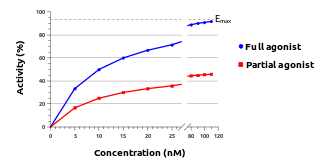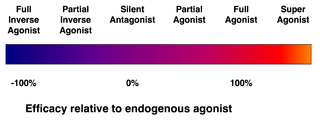Agonist
An agonist is a chemical that binds to a receptor and activates the receptor to produce a biological response. In contrast, an antagonist blocks the action of the agonist, while an inverse agonist causes an action opposite to that of the agonist.

Etymology
From the Greek αγωνιστής (agōnistēs), contestant; champion; rival < αγων (agōn), contest, combat; exertion, struggle < αγω (agō), I lead, lead towards, conduct; drive
Types of agonists
Receptors can be activated by either endogenous agonists (such as hormones and neurotransmitters) or exogenous agonists (such as drugs), resulting in a biological response. A physiological agonist is a substance that creates the same bodily responses but does not bind to the same receptor.
- An endogenous agonist for a particular receptor is a compound naturally produced by the body that binds to and activates that receptor. For example, the endogenous agonist for serotonin receptors is serotonin, and the endogenous agonist for dopamine receptors is dopamine.[1]
- Full agonists bind to and activate a receptor with the maximum response that an agonist can elicit at the receptor. One example of a drug that can act as a full agonist is isoproterenol, which mimics the action of adrenaline at β adrenoreceptors. Another example is morphine, which mimics the actions of endorphins at μ-opioid receptors throughout the central nervous system. However, a drug can act as a full agonist in some tissues and as a partial agonist in other tissues, depending upon the relative numbers of receptors and differences in receptor coupling.
- A co-agonist works with other co-agonists to produce the desired effect together. NMDA receptor activation requires the binding of both glutamate, glycine and D-serine co-agonists. Calcium can also act as a co-agonist at the IP3 receptor.
- A selective agonist is selective for a specific type of receptor. E.g. buspirone is a selective agonist for serotonin 5-HT1A.
- Partial agonists (such as buspirone, aripiprazole, buprenorphine, or norclozapine) also bind and activate a given receptor, but have only partial efficacy at the receptor relative to a full agonist, even at maximal receptor occupancy. Agents like buprenorphine are used to treat opiate dependence for this reason, as they produce milder effects on the opioid receptor with lower dependence and abuse potential.
- An inverse agonist is an agent that binds to the same receptor binding-site as an agonist for that receptor and inhibits the constitutive activity of the receptor. Inverse agonists exert the opposite pharmacological effect of a receptor agonist, not merely an absence of the agonist effect as seen with an antagonist. An example is the cannabinoid inverse agonist rimonabant.
- A superagonist is a term used by some to identify a compound that is capable of producing a greater response than the endogenous agonist for the target receptor. It might be argued that the endogenous agonist is simply a partial agonist in that tissue.
- An irreversible agonist is a type of agonist that binds permanently to a receptor through the formation of covalent bonds. A few of these have been described.[2][3]
New findings that broaden the conventional definition of pharmacology demonstrate that ligands can concurrently behave as agonist and antagonists at the same receptor, depending on effector pathways or tissue type. Terms that describe this phenomenon are "functional selectivity", "protean agonism",[4][5][6] or selective receptor modulators.[7]
Activity

Potency
Potency is the amount of agonist needed to elicit a desired response. The potency of an agonist is inversely related to its EC50 value. The EC50 can be measured for a given agonist by determining the concentration of agonist needed to elicit half of the maximum biological response of the agonist. The EC50 value is useful for comparing the potency of drugs with similar efficacies producing physiologically similar effects. The smaller the EC50 value, the greater the potency of the agonist, the lower the concentration of drug that is required to elicit the maximum biological response.
Therapeutic index
When a drug is used therapeutically, it is important to understand the margin of safety that exists between the dose needed for the desired effect and the dose that produces unwanted and possibly dangerous side-effects (measured by the TD50, the dose that produces toxicity in 50% of individuals). This relationship, termed the therapeutic index, is defined as the ratio TD50:ED50. In general, the narrower this margin, the more likely it is that the drug will produce unwanted effects. The therapeutic index emphasizes the importance of the margin of safety, as distinct from the potency, in determining the usefulness of a drug.
See also
- Allosteric modulator
- Dose response curve
- Excitatory postsynaptic potential
- Functional selectivity
- Intrinsic activity
- Inverse agonist
- Mixed agonist/antagonist
- Receptor antagonist
- Receptor theory
References
- Goodman and Gilman's Manual of Pharmacology and Therapeutics. (11th edition, 2008). p14. ISBN 0-07-144343-6
- De Mey JGR, Compeer MG, Meens MJ (2009). "Endothelin-1, an Endogenous Irreversible Agonist in Search of an Allosteric Inhibitor". Mol Cell Pharmacol. 1 (5): 246–257.
- Rosenbaum DM, Zhang C, Lyons JA, Holl R, Aragao D, Arlow DH, Rasmussen SG, Choi HJ, Devree BT, Sunahara RK, Chae PS, Gellman SH, Dror RO, Shaw DE, Weis WI, Caffrey M, Gmeiner P, Kobilka BK (January 2013). "Structure and function of an irreversible agonist-β(2) adrenoceptor complex". Nature. 469 (7329): 236–40. doi:10.1038/nature09665. PMC 3074335. PMID 21228876.
- Kenakin T (March 2001). "Inverse, protean, and ligand-selective agonism: matters of receptor conformation". FASEB J. 15 (3): 598–611. CiteSeerX 10.1.1.334.8525. doi:10.1096/fj.00-0438rev. PMID 11259378.
- Urban JD, Clarke WP, von Zastrow M, Nichols DE, Kobilka B, Weinstein H, et al. (January 2007). "Functional selectivity and classical concepts of quantitative pharmacology". J. Pharmacol. Exp. Ther. 320 (1): 1–13. doi:10.1124/jpet.106.104463. PMID 16803859.
- De Min, Anna; Matera, Carlo; Bock, Andreas; Holze, Janine; Kloeckner, Jessica; Muth, Mathias; Traenkle, Christian; De Amici, Marco; Kenakin, Terry (2017-02-24). "A New Molecular Mechanism To Engineer Protean Agonism at a G Protein–Coupled Receptor". Molecular Pharmacology. 91 (4): 348–356. doi:10.1124/mol.116.107276. PMID 28167741.
- Smith CL, O'Malley BW (February 2004). "Coregulator function: a key to understanding tissue specificity of selective receptor modulators". Endocr. Rev. 25 (1): 45–71. doi:10.1210/er.2003-0023. PMID 14769827.